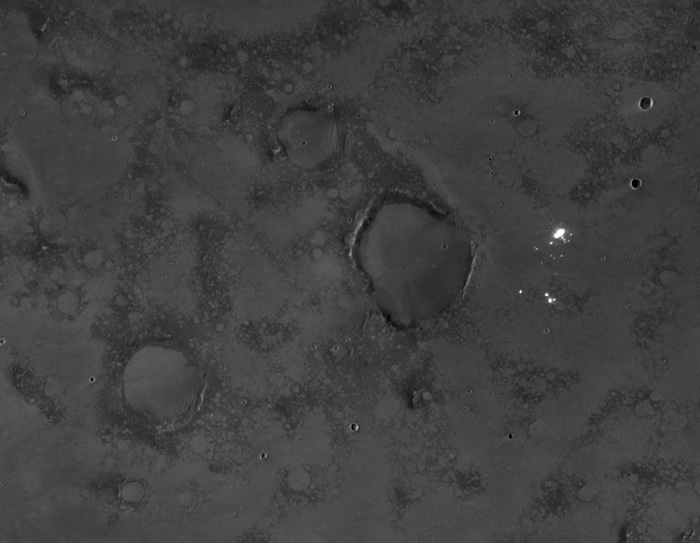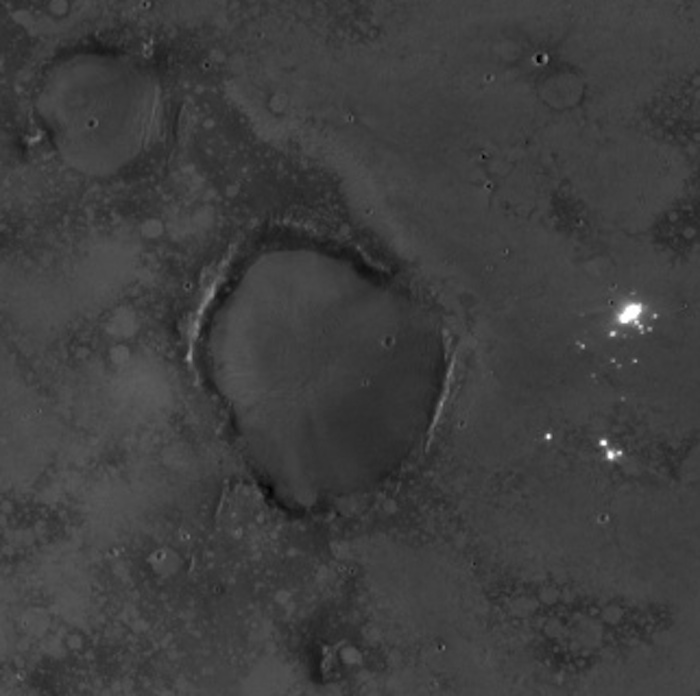.
26.09.2015

Mars has long been a mystery for those of us on earth.
But now, NASA says it has solved a Mars mystery with a major science finding.
NASA plans to reveal the Mars mystery it has solved on Monday in a press conference.
From NASA, in a release out Friday headlined "Mars Mystery Solved:"
"NASA will detail a major science finding from the agency's ongoing exploration of Mars during a news briefing at 11:30 a.m. EDT on Monday, Sept. 28 at the James Webb Auditorium at NASA Headquarters in Washington. The event will be broadcast live on NASA Television and the agency's website.
News conference participants will be:
· Jim Green, director of planetary science at NASA Headquarters
· Michael Meyer, lead scientist for the Mars Exploration Program at NASA Headquarters
· Lujendra Ojha of the Georgia Institute of Technology in Atlanta
· Mary Beth Wilhelm of NASA's Ames Research Center in Moffett Field, California and the Georgia Institute of Technology
· Alfred McEwen, principal investigator for the High Resolution Imaging Science Experiment (HiRISE) at the University of Arizona in Tucson
A brief question-and-answer session will take place during the event with reporters on site and by phone. Members of the public also can ask questions during the briefing using
Quelle: AL
---
Update: 27.09.2015
.
Entdeckungen auf dem roten Planeten
Zuletzt spürte die Sonde „Mars Reconnaissance Orbiter“ (MRO) zu Glas geschmolzenes Gestein in Kratern des roten Planeten auf.
Die beteiligten Wissenschaftler hoffen, dass das Glas Einschlüsse enthält. Darin könnten Hinweise auf früheres Leben konserviert sein.
Bestenfalls wiederholt sich ein Erfolgserlebnis von der Erde: Erst vor Kurzem wies ein Team der Brown University in Providence (US-Bundesstaat Rhode Island) im Glas von Einschlagkratern in Argentinien Spuren frühen Lebens auf der Erde nach. Sie fanden in Glas eingeschlossene Pflanzenreste an einer Stelle, an der vor Millionen Jahren ein Gesteinsbrocken aus dem All eingeschlagen war.
► Aus diesem Grund suchte die Nasa auf dem Mars nach solchen Glasablagerungen.
Seit 2006 umrundet die Marssonde den Planeten. Glasablagerungen wurden jetzt erstmals unter anderem im Krater Hargraves gefunden. Künftige Marsmissionen sollen weitere Boden- und Gesteinsproben sammeln.
.

.

.

Quelle: NASA
-
Update: 28.09.2015
.
Wondering about NASA's Mars mystery? We may have found the answer
(CNN)NASA says it has big news for us Monday. "Mars Mystery Solved," the agency's news release touts without offering even a hint as to what mystery they mean.
For those who just can't wait, a little Googling may solve the puzzle -- and it's not Matt Damon, little green people, or any other clear indication of life. It appears to be a confirmation of periodically flowing water on the planet's surface.
Three of the scientists slated for the news conference are listed as authors of a new paper to be delivered at this week's European Planetary Science Congress.
In it, the researchers say analysis of imaging from the Mars Reconnaissance Orbiter proves that seasonal dark streaks on the Martian surface are the result of briny water periodically flowing across the planet's surface.
The confirmation of water on the surface of Mars would be important and would raise a host of questions, chief among them: Where is the water coming from, and what does it mean for the prospect of life, past or present?
The paper doesn't answer those questions, and NASA isn't talking ahead of its Monday morning news conference. Neither the agency nor the paper's authors responded to requests for comment Sunday.
If Monday's announcement isn't about this specific paper, it's still likely to have something to do with water: in the soil, underground or in the atmosphere. Not only is the question of water there a hot topic for research, at least two of the authors have been heavily involved in the hunt: Alfred McEwen and Lujendra Ojha.
Both were in on the initial discovery of the dark streaks back in 2011.
But whatever NASA appears ready to announce, it looks to fall short of the breathless headlines in some media outlets suggesting the NASA may have found life on the red planet, or the endless, often absurd, speculation on social media -- home of the the Mars bunny, lizard, and myriad other claims based on photos sent back from the planet.
Social reaction to NASA's Mars announcement
Researchers have known Mars has water for many years, based on everything from photographic evidence of structures that look like riverbeds to results of scientific experiments performed aboard landers sent to the red planet.
And some have theorized for years that dark streaks -- formally called recurring slope linae -- that show up on the surface when it's warmer and fade when it's cooler suggest the presence of flowing water. In fact Ojha suggested that very mechanism in explaining his 2011 discovery but said it could be tough to prove.
Study: Water could be flowing on Mars now
Mars has liquid water just below surface
Mars has liquid water just below surface 03:35
Ojha is the primary author on the new paper, in which the researchers say analysis of spectral imaging from a tool aboard the Mars Reconnaissance Orbiter proves the streaks are in fact caused by salty water flowing downhill.
The salt content of the water is important because without it, the water would freeze in Mars' bone-chilling temperatures.
The water could be coming from subsurface ice, from salts attracting water from the thin Martian atmosphere or possibly bubbling up from an aquifer, the researchers say.
In April, McEwan announced research showing that salts in the Martian soil have the ability to grab enough water out of the air to form tiny puddles at night. And in March, NASA said Mars may once have had a sea similar to the Atlantic Ocean on Earth. About 87% of that water has been lost to space, researchers said.
Quelle: CNN
4601 Views
